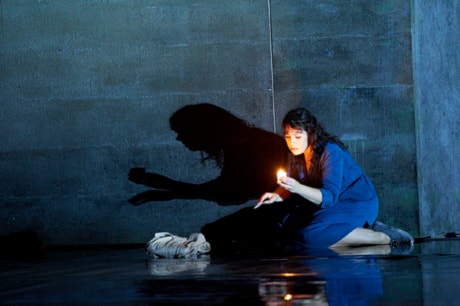TORONTO — This is definitely not your pharaoh’s Aida.
The new production by Tim Albery that opened the Canadian Opera Company’s season Saturday afternoon isn’t set in ancient Egypt as Verdi and his librettists intended. Instead, it’s been updated to our own century and set in the palace of a king whose high priest, Ramfis, wears sunglasses and a business suit.
The Triumphal Scene has no elephants, no camels — not even a Triumphal March, really. Instead, it’s depicted as the heroine’s nightmare in which Egyptian soldiers coldly shoot wounded Ethiopian warriors in the head. The Nile Scene takes place nowhere near the banks of a river, but in a palace storeroom filled with unused junk.
This pointless tinkering might not matter so much except that for a while it threatens to sabotage the main attraction: the first performance of the title role by Sondra Radvanovsky. In recent years, the American soprano has become a noted Verdi specialist, a breed that seems to be all but extinct. That she survives this production, and even triumphs in the end, is testament indeed to her talent.
When first we see Aida, a captured Ethiopian slave, she is pushing a mop across the floor, wearing a plain blue dress with pleated skirt and a baggy white sweater. In other words, she is made to look as dowdy as possible, and she spends most of the first two acts cringing uncomfortably off to one side.
In Act 3 she finally gets to strip off that sweater, and when she launches into the great aria, O patria mia (O, my country) her performance takes off. It’s like a master class in outstanding Verdi singing — strong, supple phrasing, admirable breath control, powerful high notes, ravishing pianissimos.
Radvanovsky’s voice has a distinctive shimmering quality caused by a rapid vibrato that may not be to everyone’s taste. At full volume the sound can turn steely, though it seldom becomes harsh. But she is an artist of rare gifts at a time when many Verdi heroines are almost impossible to cast.
The COC provided good support for its star. As Aida’s lover, the Egyptian warrior Radames, Australian tenor Rosario La Spina got off to a rocky start with the treacherous aria, Celeste Aida. But he soon recovered and used his warm, beefy voice well, giving an ardent, sensitively phrased performance.
The jealous princess Amneris, who wants Radames for herself, is a plum role for a powerhouse mezzo-soprano — even if in this production she is reduced to an Imelda Marcos wannabe with dozens of pairs of shoes in her closet. American mezzo Jill Grove sang fiercely and with impressive volume, especially in the Judgment Scene when she curses the priests who condemn Radames to death for treason.
Aida’s father, the Ethiopian king Amonasro, was sung by American baritone Scott Hendricks. Except for the fact that he looked several years younger than Aida, he gave a persuasive performance, filling the house with vigorous, virile sound. The veteran Canadian bass Phillip Ens brought gravitas and menace to the role of Ramfis.
The company’s music director, Johannes Debus, conducted the orchestra, which played with spirit but frequently ran ahead of the singers.
The loud ovations that greeted cast and conductor quickly turned to boos when Albery and the rest of his team came out for their curtain call. None of them looked particularly surprised by the audience’s reaction.
